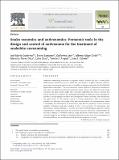Buscar
Mostrando ítems 1-5 de 5
Venomic and antivenomic analyses of the Central American coral snake, Micrurus nigrocinctus (Elapidae)
(2011-01-31)
The proteome of the venom of Micrurus nigrocinctus (Central American coral snake) was analyzed by a “venomics” approach. Nearly 50 venom peaks were resolved by RP-HPLC, revealing a complex protein composition. Comparative ...
Snake Venomics of the Central American Rattlesnake Crotalus simus and the South American Crotalus durissus Complex Points to Neurotoxicity as an Adaptive Paedomorphic Trend along Crotalus Dispersal in South America
(2010)
We report a comparative venomic and antivenomic characterization of the venoms of newborn and adult specimens of the Central American rattlesnake, Crotalus simus, and of the subspecies cumanensis, durissus, ruruima, and ...
Venoms of Micrurus coral snakes: evolutionary trends in compositional patterns emerging from proteomic analyses
(2016-11)
The application of proteomic tools to the study of snake venoms has led to an impressive growth in the
knowledge about their composition (venomics), immunogenicity (antivenomics), and toxicity (toxicovenomics).
About ...
Profiling the venom gland transcriptomes of Costa Rican snakes by 454 pyrosequencing
(BMC Genomics, 12:259, 2011, 2011)
Background: A long term research goal of venomics, of applied importance for improving current antivenom
therapy, but also for drug discovery, is to understand the pharmacological potential of venoms. Individually ...
Snake venomics and antivenomics: Proteomic tools in the design and control of antivenoms for the treatment of snakebite envenoming
(2009-03-06)
Snakebite envenoming represents a neglected tropical disease that has a heavy public health impact, particularly in Asia, Africa and Latin America. A global initiative, aimed at increasing antivenom production and ...



